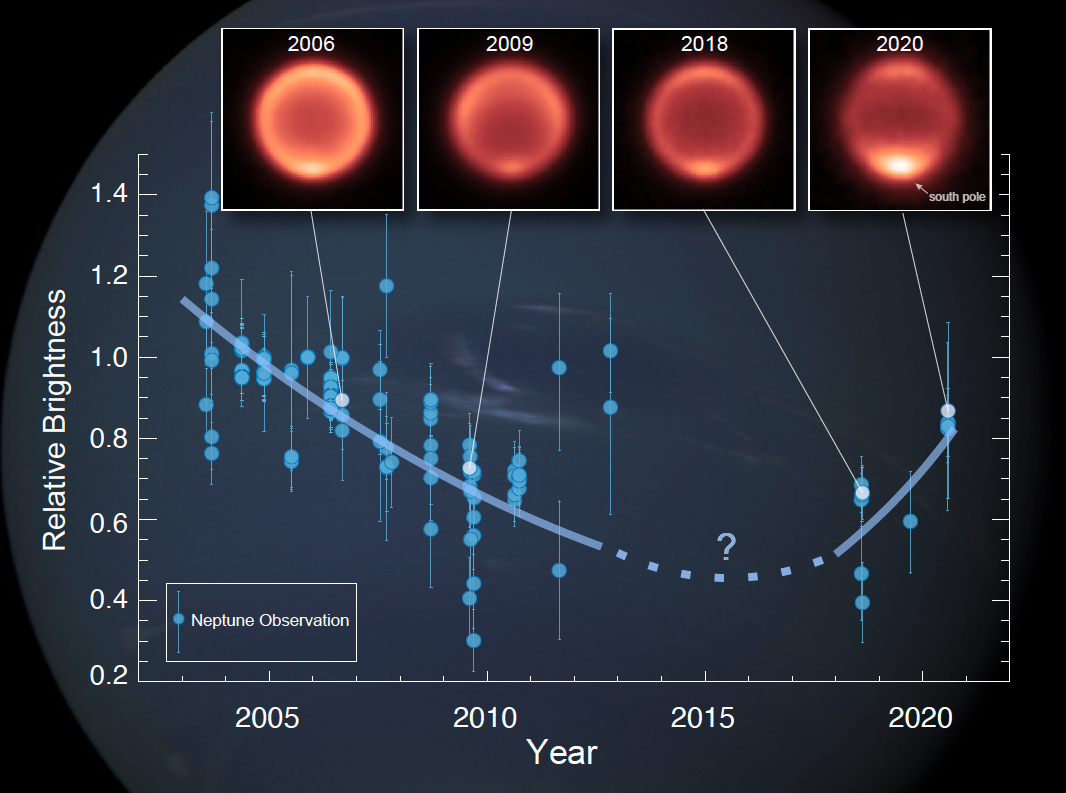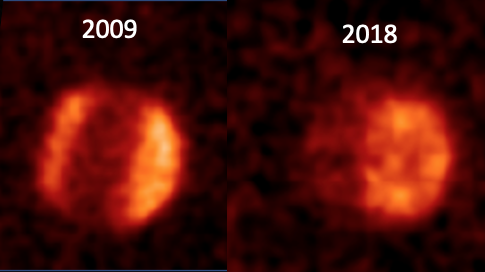Uranus and Neptune in the Mid-Infrared: Recent Findings from VLT-VISIR and Future Opportunities with JWST-MIRI
- 1University of Leicester, School of Physics and Astronomy, Leicester, United Kingdom of Great Britain – England, Scotland, Wales (mr359@le.ac.uk)
- 2Jet Propulsion Laboratory/California Institute of Technology, 4800 Oak Grove Dr, Pasadena, CA 91109, USA
- 3NASA Goddard Space Flight Center, Astrochemistry Laboratory, Code 691, Greenbelt MD 20771 USA
- 4Howard University, Department of Physics and Astronomy, 2355 6th St NW, Washington, DC 20059, USA
- 5Space Science Institute, Boulder, CO 80301, USA
- 6Southwest Research Institute, San Antonio, TX, USA
- 7University of Oxford Atmospheric, Oceanic, and Planetary Physics, Department of Physics, Clarendon Laboratory, Parks Road, Oxford OX1 3PU, United Kingdom
- 8Planetary Plasma and Atmospheric Research Center, Graduate School of Science, Tohoku University, Sendai, Miyagi, 980-8578, Japan
- 9Subaru Telescope, National Astronomical Observatory of Japan, 650 North A’ohoku Pl., Hilo, HI 96720, USA
- 10Association of Universities for Research in Astronomy, 1212 New York Avenue NW, Suite 450, Washington, DC 20005, USA
- 11Department of Astronomy, 501 Campbell Hall, University of California at Berkeley, Berkeley, CA, USA
- 12UPV/EHU, Escuela Ingernieria de Bilbao, Fisica Aplicada, Spain
In this talk, we present highlights from our recent analyses of mid-infrared observations of Uranus and Neptune, and we look ahead to anticipated discoveries from the James Webb Space Telescope.
Drawing from a combination of archival and recent ground-based imaging and spectroscopy, we examine the spatial structure and trends of mid-infrared emission from the ice giant atmospheres. We report on surprising temporal variability in the atmosphere of Neptune (see Figure 1) with an unexpected decline in stratospheric temperatures since at least 2003. Recent VLT-VISIR imaging and spectroscopy are presented, revealing how this trend has progressed.
In contrast, we show that no evidence yet exists of long-term thermal changes in Uranus’ stratosphere, but mid-IR observations of Uranus are still extremely limited. The observed spatial structure of Uranus’ mid-infrared emission is intriguing (Figure 2), as it is inconsistent with simple models of the atmospheric circulation and/or chemistry and its physical interpretation remains unclear. We share recent observations from VLT-VISIR and express the need for continued ground-based imaging for both Uranus and Neptune.
Finally, we discuss how the James Webb Space Telescope MIRI observations will help greatly advance our understanding of the ice giants in the years ahead. In particular, given its supreme sensitivity compared to ground-based observations, JWST-MIRI observations will resolve the nature of Uranus stratospheric thermal/chemical structure and reveal how temperature and chemical abundances change with the seasons in the atmospheres of both ice giants.

Figure 1: Observed changes in Neptune’s thermal-infrared brightness, a measure of temperature in Neptune’s atmosphere. The plot shows the relative change in the thermal-infrared brightness from Neptune’s stratosphere with time for all existing images taken by ground-based telescopes. Brighter images are interpreted as warmer. Corresponding thermal-infrared images (top) at wavelengths of ~12 µm show Neptune’s appearance in 2006, 2009, 2018 (observed by the European Southern Observatory’s Very Large Telescope VISIR instrument), and 2020 (observed by Subaru’s COMICS instrument). The south pole appears to have become dramatically warmer in just the past few years.

Figure 2: Uranus' 13-micron images from VLT-VISIR in 2009 and 2018, with enhanced emission from high latitudes. From current ground-based observations alone, it is unclear whether the enhanced radiances are due to greater temperatures or enhance acetylene abundances, but JWST will solve this mystery.
How to cite: Roman, M. T., Fletcher, L. N., Orton, G. S., Rowe-Gurney, N., Moses, J., Greathouse, T. K., Irwin, P. G. J., Kasaba, Y., Fujiyoshi, T., Hammel, H. B., de Pater, I., Antunano, A., Sinclair, J., Melin, H., and Bardet, D.: Uranus and Neptune in the Mid-Infrared: Recent Findings from VLT-VISIR and Future Opportunities with JWST-MIRI, Europlanet Science Congress 2022, Granada, Spain, 18–23 Sep 2022, EPSC2022-594, https://doi.org/10.5194/epsc2022-594, 2022.

